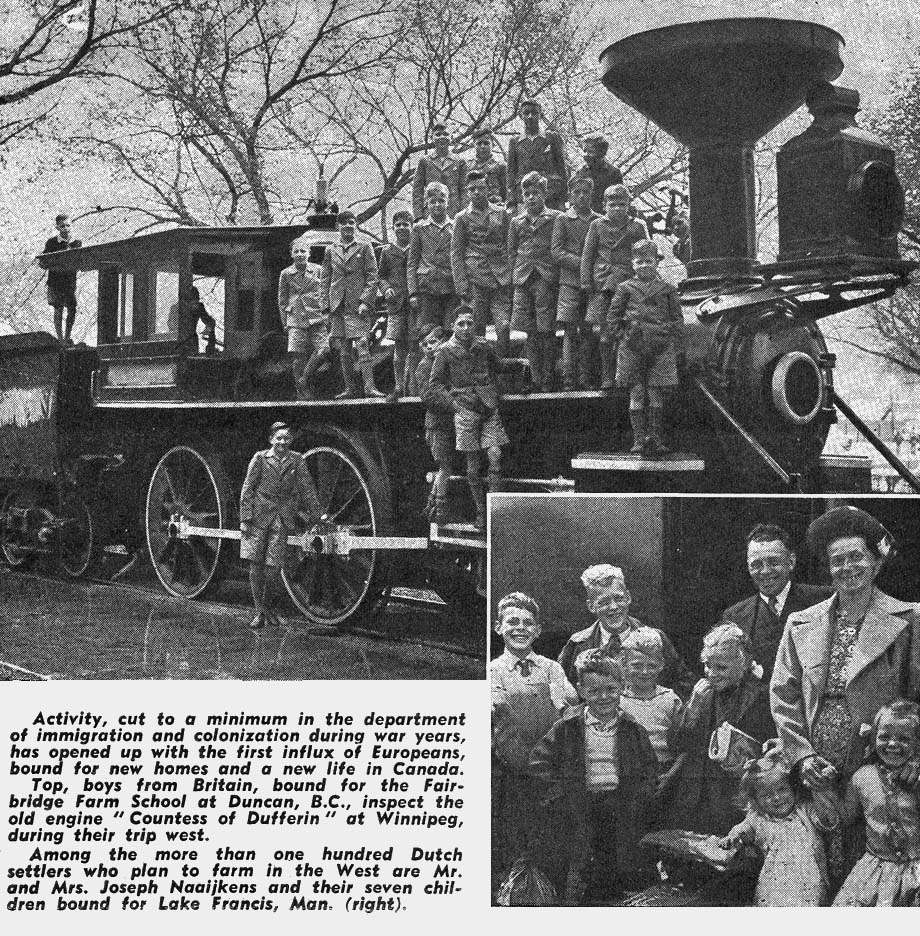
October - 1947
Settles 9,435 Families on Western Canada Farms
With 2 1/2 Million Acreage Costing
$55,000,000

How does an immigrant become a settler? What happens to him after he steps off the boat onto a foreign shore, with his odd bits of luggage, foreign money in his pocket, and a foreign tongue in his head? Who guides him through the first few months when he is becoming settled, learning the currency, the language, the habits, customs, and colloquialisms of a new neighbourhood? There are a thousand and one things that affect the every day life of a native of the country which are taken for granted. To a newcomer they are strange, fascinating, and frightening. To many people who come to Canada to settle the answer is the Canadian Pacific.
Company Plays Part
More specifically it's the Company's department of immigration and colonization and its western affiliate, the Canada Colonization Association. Since its inception more than 60 years ago, the department has been one of the leading components in introducing new Canadians to their country by adoption. Through it, individuals as well as large groups of persons from other lands have been brought to Canada, shepherded through the first few months of hardships, and guided into the national life of the Dominion until they have become an integral part of their community and a strengthening cog in the economy of the country.
The immigration and colonization department of the Company started its work of bringing settlers to Canada in the same year that the Company was formed, and before the construction of the railway had started. Since that time it has been instrumental in bringing thousands of immigrants to Canada and settling them on farms and in the country's industrial plants. The Canada Colonization Association alone, since it was taken over by the Company in 1925, has established 9,435 families on farms in western Canada with a total acreage of nearly two and a half million, costing in the neighbourhood of $55,000,000. This does not include the hundreds of single persons who have been placed on farms and in factories through the assistance of the department.
In nearly every province in Canada the department is represented by agents, well versed in the business of colonization, and it is these men who each year make a survey of the farms in their area to determine how many settlers can be placed on the land, and it is these men who have personal contact with the new Canadians, Help them with their difficulties, assist them in buying land, advising them on the type of machinery and seed to get, and prevent them from falling into the hands of unscrupulous persons who may take advantage of the immigrants' handicaps and enforced ignorance.
The department of immigration and colonization has also taken an active interest in the bringing of children to Canada, and two of these schemes in particular deserve mention. The British Students for Macdonald College scheme was started in 1926 and up until the outbreak of the second world war large numbers of agricultural students had taken advantage of it.
Between terms, employment on farms was found for them, and following their graduation they were assisted in getting located on farms of their own throughout Canada. The Fairbridge Farm School at Duncan, B.C., is a similar project. Here boys and girls from the British Isles are taught farm work and later are aided in obtaining employment. The school has been operating since 1935.
To enable the department to handle the many complexities of immigration and colonization before the second World War, it had offices in many countries of Europe where people wishing to come to Canada could obtain information on the area in which they wished to settle, assistance in interpreting existing government regulations, and advice on what to take with them as well as assistance in the actual travelling to be done.
 and is reprinted here with their permission. All photographs,
logos, and trademarks are the property of the Canadian Pacific Railway Company.
and is reprinted here with their permission. All photographs,
logos, and trademarks are the property of the Canadian Pacific Railway Company.